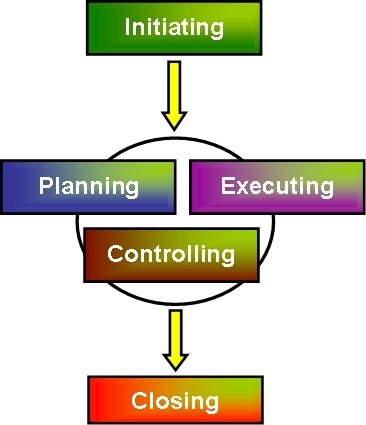
Features
Efficiency
Energy
Journey to Energy Excellence for Greenhouses – Part 4
July 5, 2012 By Treena Hein
 This graphic shows the phases of stage 4 of 360 Energy's 'The Journey to Energy Excellence for Greenhouses.'
This graphic shows the phases of stage 4 of 360 Energy's 'The Journey to Energy Excellence for Greenhouses.' Step 4 in ‘The Journey to Energy Excellence for Greenhouses’ from 360 Energy is ‘Plan Implementation.’ “Now that an organization has made the decision to go on the ‘Journey’ and has written a sustainable energy plan/program, the fourth step is to begin implementing that plan,” says Quality Assurance Supervisor Lisa Brodeur.
Implementation is a simple 5 phase process that any organization can complete. The key is to start and be persistent.
Phase one is initiation. This is the phase where you review your energy plan and determine actions to implement based on listed priorities. In the plan, you identified not only actions but also who would be involved, allocation of time and forecasted expected benefits by taking action. Time must be allocated to organize the appropriate resources internally and externally to start and complete implementing the action items – arrange financing, your growers and outside suppliers/pending vendors (for example boiler service providers, utilities).
Once you are ready to implement, beware that sometimes the action required at the beginning is laying the foundation so you can obtain savings. As an example, if you don’t have a system to monitor and track your energy usage and costs, it’s very difficult to identify what you should focus on and if your actions have created savings.
Phase two – planning the implementation, is critical, as without it, you may miss key pieces of your implementation, the process may not run smoothly and final results may not have the same financial implications as originally expected. We always encourage customers to focus on no-cost or low-cost options initially to help pay for capital projects. Keep in mind however, that although no-cost and low-cost have great ROI’s they do require a variety of resources to be involved to achieve the savings.
Long-term sustainability is achievable if the plan for each energy action item is completed early in the implementation process. Planning should outline the scope of the action, tasks to complete the scope, the resources required for each of those tasks and the schedule for when they will be accomplished. A risk analysis should be conducted as well at this time, to ensure any potential risks are outlined before work begins.
Phase three and four work hand in hand with one another. Phase three, executing, involves assigning responsibilities for the tasks outlined and developing detailed schedules and budgets to go with them. It’s essential that various parties (internal and external) clearly understand their role and what is expected of them.
Phase four, controlling the project, is the active management of the energy action being put in place. This is where monitoring progress and measuring your achievements is undertaken. This includes tracking your progress against your predetermined schedule and budget, collecting data to determine your baseline and verifying your results against predetermined metrics for the action item.
In this phase, it is important for on-going communication (progress reports, problems, budgets) be at the forefront of everyone’s minds. Communication regarding the logistics of the action being implemented, will keep all appropriate parties up to date on the current status and help ease any transition required.
Phase five is closing. This is the end of the implementation process and the amount of documentation at this point will really depend on the size and complexity of the action item implemented. Feedback is a critical element of this phase, reporting back to management and staff of the results obtained, changes to processes and procedures, training required and any new documentation that should be read. It keeps all parties informed and moving forward, working towards a common goal, creating common ground between upper management and greenhouse employees.
The five phases of implementation help deliver an energy action item on time and on budget. It provides you the opportunity to use resources efficiently and effectively. Planning and communication are the keys to success, while a failure to plan is planned failure. Look for the final stage of the Journey to Energy Excellence for Greenhouses (Monitoring and Feedback) in two weeks time.
Lisa Brodeur is a Quality Assurance Specialist with 360 Energy.
Print this page